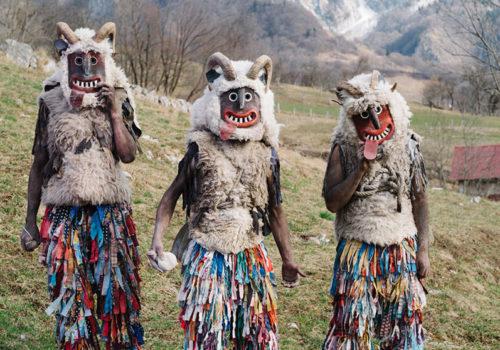Story : Monsters of Spring, Shrovetide
Ciril Jazbec is a Slovenian photographer and film director. His work focuses on communities that are confronted by the effects of globalization and the climate crisis. In his long-term projects, he aims to raise awareness about the deterioration of our planet and the increasing impact of the climate crisis. He has seen the rising sea levels in Kiribati, the erosion and melting of permafrost in Alaska, and has spent over seven months in Greenland documenting climate effects on the Inuits. His latest multimedia project took him to the Himalayas, the Alps, and the Andes on a quest to understand how people are addressing the climate change crisis.
Jazbec studied Management at the Faculty of Economics in Ljubljana before moving to London to study photography. He gained an MA in Photojournalism and Documentary Photography from the London College of Communication in 2011.
His awards include the World Press Photo Award in 2021, the Leica Oskar Barnack Newcomer Award in 2013, Photo Folio Review Les Rencontres d’Arles winner in 2013, Magnum 30 under 30 in 2015, PDN’30 New and Emerging Photographers to Watch in 2016, and the Pictures of the Year International World Understanding Award in 2018. His film “Dream to Cure Water” won in the climate stories category at the Jackson Wild Media Awards in 2023
Jazbec has been a contributing photographer and filmmaker for National Geographic Magazine since 2014 and is a National Geographic Explorer. His works have been exhibited and presented in various venues including Les Rencontres d’Arles, Visa pour l’Image, Photoville, Lumen Museum, PhEST, Format Festival, The Annenberg Space for Photography, Newseum, East Wing Gallery, The Royal Geographical Society, The New York Public Library etc.
https://www.ciriljazbec.com
Instagram: @ciriljazbec
Patricia Lanza: As a Native Slovenian, discuss how you came to discover the Shrovetide customs, their meaning and history?
Ciril Jazbec : As a native Slovenian, I was introduced to the Shrovetide customs, or “Pust,” at a young age through family and community traditions. The meaning of Pust, rooted in ancient traditions, is to chase away winter and welcome spring. The history of Pust is rich and dates back to pre-Christian times. It almost vanished due to disapproval from church leaders and later, a socialist regime, but it has survived and remains one of Slovenia’s most significant cultural events. The customs and characters of Pust have been passed down through generations, preserving our cultural heritage.
Lanza : How is this custom practiced and has evolved for continuity within the community?
Jazbec : The Pust festival is celebrated in every town and city in Slovenia, usually in February or early March. It is a movable celebration that occurs 47 days before Easter. The customs are maintained through community involvement and the passing down of traditions. For instance, the Kurentovanje in Ptuj is a renowned celebration that features “kurenti,” monsters that attract large crowds with their cowbells and masks. The details of the celebrations may differ regionally, but the essence remains the same—ushering out winter and welcoming spring. Efforts to protect Pust as part of Slovenia’s cultural heritage have helped ensure its continuity.
Jazbec : How does Shrovetide work?
Lanza : Shrovetide, or Pust, works as a series of festivities that culminate in a grand parade. The festival features various characters like the “Beautiful Ones” and the “Ugly Ones,” each playing vital roles. The “Beautiful Ones” bring good luck by visiting homes, while the “Ugly Ones” create mischief to chase away winter. These characters perform rituals, such as “baptizing” boys into manhood using socks filled with ash. The festival ends with the burning of a straw doll representing winter, symbolizing its end and the arrival of spring.
Lanza : Discuss how Shrovetide is celebrated from village to village—the similarities and differences?
Jazbec : Shrovetide is celebrated throughout Slovenia, but each village has its unique variations. For example, the Kurentovanje in Ptuj is famous for its kurenti monsters, while Ravenski Pust involves young men dressed as “Ugly Ones” dusting boys with ash. Drežnica Pust includes a trial and execution by shotgun before burning Pust. Despite these regional differences, common elements include parades, masked characters, and the symbolic burning of winter. These variations may seem minor to outsiders but are significant to locals, highlighting the rich diversity within Slovenian culture.
Lanza : Discuss the deeper meaning of the ritual of Shrovetide, the Pust Festival and rites of passage for the participants?
Jazbec : The deeper meaning of Shrovetide and the Pust Festival lies in its symbolic rites of passage and the cycle of seasons. For many, Pust is a rite of passage where boys transition into men through playful yet meaningful rituals involving ash. These customs connect the community, reinforcing social bonds and cultural identity. The festival also marks the end of winter and the beginning of spring, embodying renewal and transformation. The “Beautiful Ones” and “Ugly Ones” symbolize the duality of life, celebrating both the light and dark aspects of existence.
Lanza : What are you looking to do with this photographic and film work and your current projects?
Jazbec : Through my photographic and film work, I aim to capture the essence and beauty of the Pust Festival and its significance to Slovenian culture. I want to document and share these traditions with a broader audience, preserving them for future generations and highlighting their cultural importance. My current projects focus on exploring various regional celebrations of Pust, showcasing the diversity and richness of these customs. By doing so, I hope to foster a deeper understanding and appreciation of Slovenia’s cultural heritage.
Text & Interview Patrica Lanza
















